IDEX Online Research: Polished Diamond Prices Rise Solidly in December (Full Analysis)
January 05, 11
(IDEX Online) - After bottoming in September 2009, the IDEX Online Global Polished Price Index has risen almost every month. In December 2010, average polished diamond prices gained 0.6 percent compared to November and more than 8 percent year-over-year. For 2010, global polished diamond prices rebounded by 6 percent.
The IDEX Online Global Polished Price Index increased constantly from a low of 108.56 in September 2009 until the end of August 2010. In September and October, polished diamond prices wilted, only to press ahead again in November and December 2010.
The graph below summarizes the diamond price index by month for the past two years. As the graph illustrates, prices have risen at a steady, consistent level, with pauses in July, September and October of this year, followed by a recovery in November and a solid gain in December.
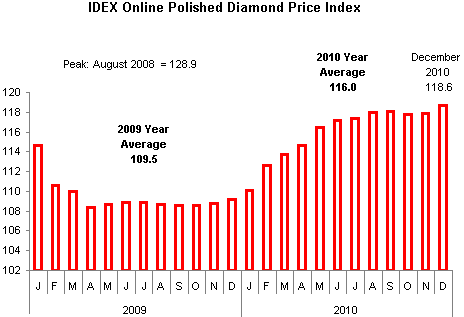
Source: IDEX Online
The graph below illustrates daily price movement for polished diamonds for the past three months. While there is day-to-day volatility – characteristic of normal trading conditions as well as typical in a recovery period – the trend is clear: polished diamond prices are rising.
The red line on the graph represents the three-month trend line for polished diamond prices, based on daily prices.
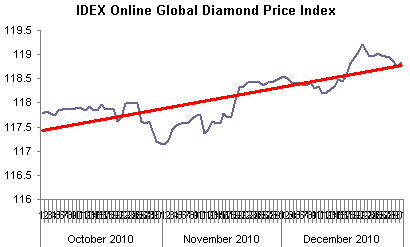
Source: IDEX Online
Month-to-Month Polished Diamond Prices Up Solidly in December
The IDEX Online Global Polished Price Index averaged 118.6 in December 2010, a robust 0.6 percent increase over November’s 117.9.
During an economic recovery cycle, there is often volatility in month-to-month indices such as the IDEX Polished Diamond Price Index as the economy lurches ahead at an uncertain pace.
The graph below illustrates month-to-month price changes for polished diamonds. The lack of price momentum is clear in July, September, October and to some extent, November. Earlier this year, polished diamond prices posted solid month-to-month gains, a trend which recurred in December.
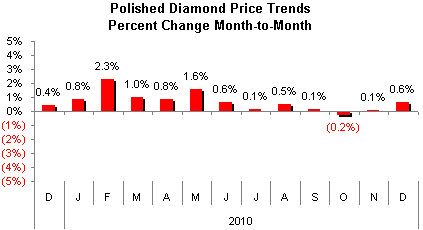
Source: IDEX Online
Year-to-Year Polished Diamond Prices Up Due to Easy Comparisons
The IDEX Online Global Polished Diamond Price Index for December 2010 – 118.6 – was a strong 8.6 percent higher than the average for December 2009.
December was the eleventh consecutive month that prices have risen on a year-to-year basis. After more modest year-to-year price increases in October and November, the December price gain was notable, especially since comparisons were a bit more difficult against December 2009 than in prior months.
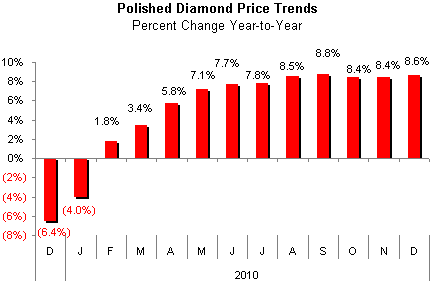
Source: IDEX Online
Diamond Prices Changes by Size Were Uneven, but Up, In December
On a month-to-month comparison, key diamond sizes reflected a wide range of price changes in December, when compared to November 2010 prices. Those price changes were uneven: 3- and 4-carat diamonds posted a solid gain in price, while smaller carat gemstones experienced a smaller gain in price. Further, there was little increase in the price of 5-carat diamonds.
The graph below illustrates price changes for various carat sized diamonds during December, when compared to the prior month.
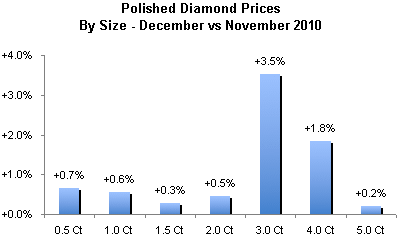
Source: IDEX Online
With the exception of three-carat polished diamond gemstones, year-over-year prices were fairly even across all sizes. The spike in prices of three-carat diamonds reflects a recent trend.
It is important to note that the year-over-year polished diamond price comparisons in December remained fairly easy, since the IDEX Online Polished Diamond Price Index was still near its bottom a year ago. Thus, we would expect large percentage gains this year.
“Snapshot” graphs of a single month are less meaningful than overall trends; diamantaires should look at the longer term movement of the IDEX Online Global Polished Diamond Price Index which illustrates that polished diamond prices have been moving broadly higher, despite pauses in July and September, as well as October.
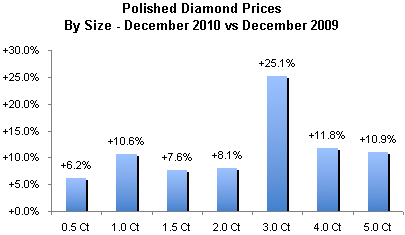
Source: IDEX Online
The graph below summarizes three years of price movement of polished diamonds by various key sizes.
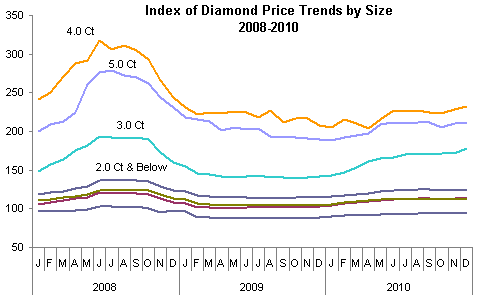
Source: IDEX Online
Annual Diamond Price Levels on Trend
Polished diamond prices have historically shown an annual price increase in the low single digit range. For 2005, 2006, and 2007, polished diamond prices rose by about 2 percent annually, slightly under the yearly long term price increase of 2-3 percent.
However, in 2008 – dubbed the “Bubble Year” – prices rose by 9 percent, only to fall by about 13 percent in 2009.
In 2010, global polished diamond prices rebounded by 6 percent. This large gain is typical of a “recovery rate,” since prices had fallen so dramatically the prior year.
Interestingly, when a trend line is plotted for long term diamond prices, they appear to be right on trend for 2010, after the bubble of 2008 and the sharp decline in 2009.
The graph below, which illustrates long term polished diamond prices with the trend line in red, is a perfect example of the statistical phenomenon of “reversion to the mean.” For three years, the average price increase was about the same each year. That was followed by a price bubble in 2008 and a price bust in 2009.
Prices in 2010 recovered roughly to the average trend line of the “normal” years – a reversion to the mean. This is characteristic of the diamond industry: things change by evolution, not by revolution. We are also seeing a “reversion to the mean” in consumer expenditures for jewelry; they are returning, more or less, to their pre-recession spending habits.
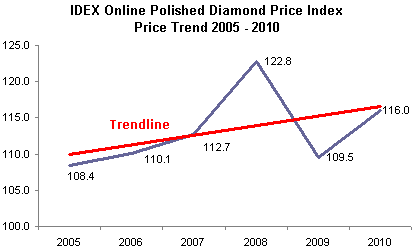
Source: IDEX Online
Outlook: Higher Polished Diamond Prices Likely
With a successful holiday selling season buoying diamantaires’ confidence, polished diamond prices are headed higher, in our view.
We worry about the ending of generic diamond advertising in the U.S., but know the residual impact of the powerful phrase “A Diamond Is Forever” will continue to help support demand near term.
Further, the market is shifting toward fashion diamond jewelry, rather than diamond items like solitaire stones on a chain or mounted in a ring. Thus, it is likely that demand for smaller stones will be solid.
While there are conflicting forecasts related to the number of projected weddings in the U.S. market over the next decade, we are forecasting an increase of at least 20-25 percent in weddings – to at least 2.6 million annually. This should help boost demand for big-ticket diamond engagement rings.
Finally, pressure from higher prices for rough diamonds will cause polished diamond prices to rise longer term.
One interesting observation: now that De Beers has eliminated its generic diamond advertising, we are yet to see new forecasts for diamond demand versus diamond supply for the long term. At one time, it was clear that the demand for diamonds, especially from the consumer segment, would far outstrip the ability of the mining segment to supply enough stones. Perhaps the move by consumers toward fashion jewelry – utilizing all kinds of gemstones and precious metals, rather than just diamonds – will help ease the long term imbalance between diamond supply and demand.